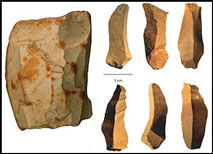Article contents
The effects of heavy-duty machinery on the formation of pseudo-knapping debitage in Stone Age cultural landscapes
Published online by Cambridge University Press: 11 December 2018
Abstract

The risk to surface archaeological sites posed by heavy machinery has grown significantly, and stone-tool assemblages are particularly susceptible to alteration that may be difficult to recognise. Indeed, the impact of industrial machines on surface scatters of lithic material has not yet been explored. Here, an analytical experiment is used to explore the ways in which machine action can affect a test assemblage resembling a typical Stone Age scatter. The results demonstrate that while formal tool types are not easily replicated through machine action, the creation of assemblages that resemble archaeological debitage poses a much greater challenge for archaeologists.
- Type
- Research
- Information
- Copyright
- Copyright © Antiquity Publications Ltd, 2018
References
- 1
- Cited by




